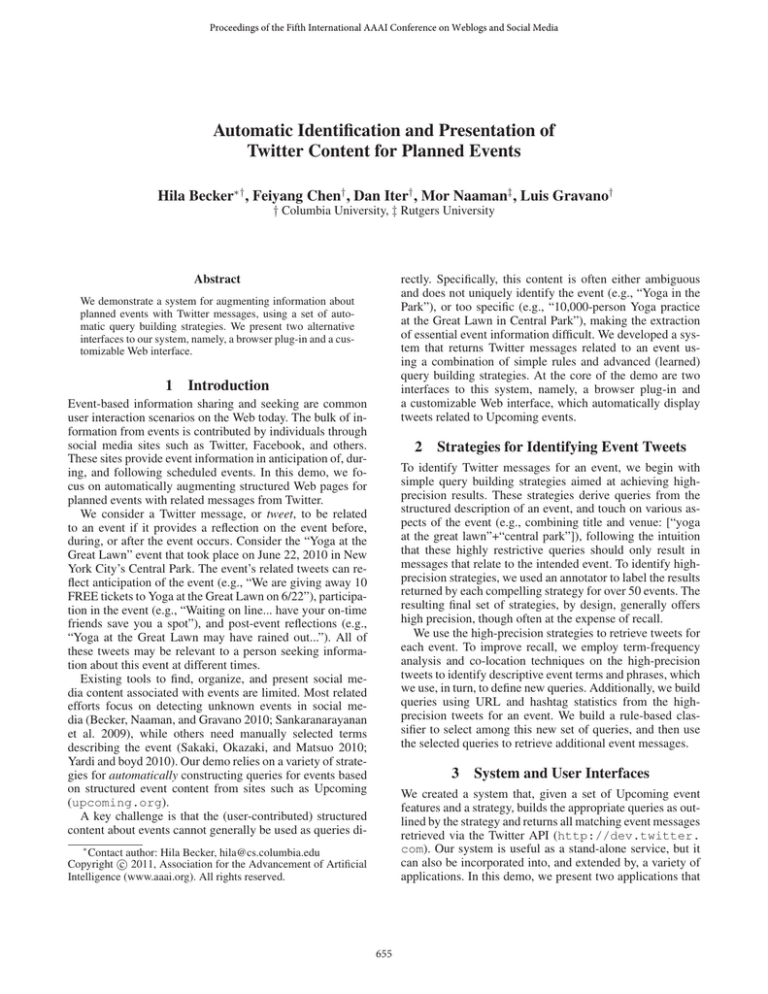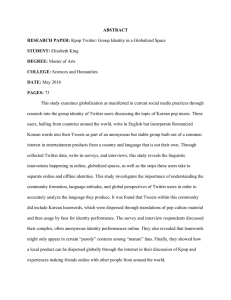
Proceedings of the Fifth International AAAI Conference on Weblogs and Social Media
Automatic Identification and Presentation of
Twitter Content for Planned Events
Hila Becker∗† , Feiyang Chen† , Dan Iter† , Mor Naaman‡ , Luis Gravano†
† Columbia University, ‡ Rutgers University
rectly. Specifically, this content is often either ambiguous
and does not uniquely identify the event (e.g., “Yoga in the
Park”), or too specific (e.g., “10,000-person Yoga practice
at the Great Lawn in Central Park”), making the extraction
of essential event information difficult. We developed a system that returns Twitter messages related to an event using a combination of simple rules and advanced (learned)
query building strategies. At the core of the demo are two
interfaces to this system, namely, a browser plug-in and
a customizable Web interface, which automatically display
tweets related to Upcoming events.
Abstract
We demonstrate a system for augmenting information about
planned events with Twitter messages, using a set of automatic query building strategies. We present two alternative
interfaces to our system, namely, a browser plug-in and a customizable Web interface.
1
Introduction
Event-based information sharing and seeking are common
user interaction scenarios on the Web today. The bulk of information from events is contributed by individuals through
social media sites such as Twitter, Facebook, and others.
These sites provide event information in anticipation of, during, and following scheduled events. In this demo, we focus on automatically augmenting structured Web pages for
planned events with related messages from Twitter.
We consider a Twitter message, or tweet, to be related
to an event if it provides a reflection on the event before,
during, or after the event occurs. Consider the “Yoga at the
Great Lawn” event that took place on June 22, 2010 in New
York City’s Central Park. The event’s related tweets can reflect anticipation of the event (e.g., “We are giving away 10
FREE tickets to Yoga at the Great Lawn on 6/22”), participation in the event (e.g., “Waiting on line... have your on-time
friends save you a spot”), and post-event reflections (e.g.,
“Yoga at the Great Lawn may have rained out...”). All of
these tweets may be relevant to a person seeking information about this event at different times.
Existing tools to find, organize, and present social media content associated with events are limited. Most related
efforts focus on detecting unknown events in social media (Becker, Naaman, and Gravano 2010; Sankaranarayanan
et al. 2009), while others need manually selected terms
describing the event (Sakaki, Okazaki, and Matsuo 2010;
Yardi and boyd 2010). Our demo relies on a variety of strategies for automatically constructing queries for events based
on structured event content from sites such as Upcoming
(upcoming.org).
A key challenge is that the (user-contributed) structured
content about events cannot generally be used as queries di-
2
Strategies for Identifying Event Tweets
To identify Twitter messages for an event, we begin with
simple query building strategies aimed at achieving highprecision results. These strategies derive queries from the
structured description of an event, and touch on various aspects of the event (e.g., combining title and venue: [“yoga
at the great lawn”+“central park”]), following the intuition
that these highly restrictive queries should only result in
messages that relate to the intended event. To identify highprecision strategies, we used an annotator to label the results
returned by each compelling strategy for over 50 events. The
resulting final set of strategies, by design, generally offers
high precision, though often at the expense of recall.
We use the high-precision strategies to retrieve tweets for
each event. To improve recall, we employ term-frequency
analysis and co-location techniques on the high-precision
tweets to identify descriptive event terms and phrases, which
we use, in turn, to define new queries. Additionally, we build
queries using URL and hashtag statistics from the highprecision tweets for an event. We build a rule-based classifier to select among this new set of queries, and then use
the selected queries to retrieve additional event messages.
3
System and User Interfaces
We created a system that, given a set of Upcoming event
features and a strategy, builds the appropriate queries as outlined by the strategy and returns all matching event messages
retrieved via the Twitter API (http://dev.twitter.
com). Our system is useful as a stand-alone service, but it
can also be incorporated into, and extended by, a variety of
applications. In this demo, we present two applications that
∗
Contact author: Hila Becker, hila@cs.columbia.edu
c 2011, Association for the Advancement of Artificial
Copyright Intelligence (www.aaai.org). All rights reserved.
655
Figure 1: System diagram (a), browser plug-in (b), and customizable interface (c).
build on this query formulation system to create two user
experiences for interacting with tweets for planned events.
3.1
include options for ranking the tweets according to various
criteria. One such ranking criterion is to order the tweets
according to the time at which they were posted, in case a
user is interested in the most up-to-date information about
an event. Another ranking option orders tweets according to
the number of strategies for which they were retrieved. In the
future, we plan to experiment with richer ranking functions.
This interface provides flexibility by allowing users to dynamically modify the set of retrieval strategies, which is particularly useful when the high-precision strategies have insufficient recall. Another feature is a user-driven option to
remove generally high-precision strategies when they are expected to introduce noise for a specific event: for example,
this scenario might happen with a “title-only” query strategy
when an event title is ambiguous (e.g., “4th of July Celebration,” referring to an event in Charleston, SC).
Browser Plug-In
Our first sample application uses a browser plug-in script
that enables seamless embedding of tweets related to
planned events on Upcoming (Figure 1(b)). This plug-in
script calls a query formulation engine with a set of preconfigured querying strategies (Figure 1(a)), which can be
modified via plug-in settings, or dynamically selected based
on event type. When a user navigates to an Upcoming event
page, the plug-in script collects the event ID and associated
event features, and sends them to the query formulation engine, along with the selected query building strategies. The
query formulation engine automatically constructs appropriate event-specific queries using the event’s features, as required by each query building strategy. The engine then collects all of the matching messages from Twitter, and finally
sends the results to the plug-in script.
For efficiency, we issue asynchronous requests to the
query formulation engine, where each strategy corresponds
to one request, and post the tweets in the order in which they
are returned. We use a hash-map to keep track of all tweets
that are already displayed on the page, in order to avoid displaying duplicate messages, which may be returned by the
different strategies. Additional performance improvement is
gained from issuing a request for any locally cached tweets
(see local tweets database in Figure 1(a)) that were previously retrieved for this event by any user of our system. We
dynamically append the resulting tweets to the Upcoming
page, alongside the event description.
3.2
4
Conclusion
We present a system that uses a variety of query building strategies, aimed at automatically augmenting usercontributed information for planned events with dynamically generated Twitter content. Our demo system enables
experimentation and exploration of substantially different
query formulation strategies for the important task of identifying relevant Twitter content for planned events.
5
Acknowledgments
This material is based on work supported by NSF Grants
IIS-0811038, IIS-1017845, and IIS-1017389, and by two
Google Research Awards. In accordance with Columbia
Univ. reporting requirements, Prof. Gravano acknowledges
ownership of Google stock as of the writing of this paper.
Customizable Web-based Interface
Our customizable interface enables users to select specific
strategies for automatically retrieving tweets for any given
Upcoming event. Through this interface, users can either
search for events or select from a list of recent Upcoming
events (Figure 1(c)). On the sidebar, we display the list of
query building strategies that, if checked, will be used in the
retrieval process. When a user selects the “search for tweets”
link for an event, our interface issues simultaneous, asynchronous calls to our query formulation engine, to retrieve
tweets for this event according to each selected strategy.
We display the Twitter messages dynamically, as soon as
they are retrieved, for efficiency reasons. However, we also
References
Becker, H.; Naaman, M.; and Gravano, L. 2010. Learning similarity metrics for event identification in social media. In WSDM’10.
Sakaki, T.; Okazaki, M.; and Matsuo, Y. 2010. Earthquake shakes
Twitter users: Real-time event detection by social sensors. In
WWW’10.
Sankaranarayanan, J.; Samet, H.; Teitler, B. E.; Lieberman, M. D.;
and Sperling, J. 2009. Twitterstand: News in tweets. In GIS’09.
Yardi, S., and boyd, d. 2010. Tweeting from the town square:
Measuring geographic local networks. In ICWSM’10.
656








